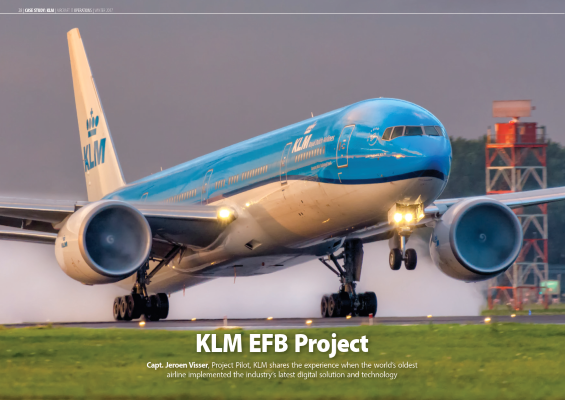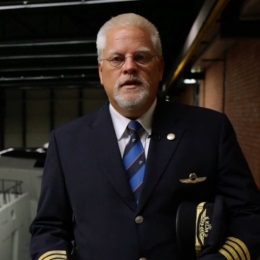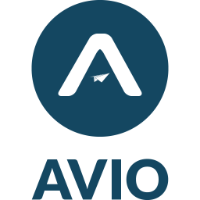Articles
| Name | Author |
|---|
Case Study: KLM EFB Project
Author: Capt. Jeroen Viser, Project Manager, KLM
SubscribeKLM EFB Project

Capt. Jeroen Viser, Project Manager, KLM shares the experience when the world’s oldest airline implemented the industry’s latest digital solution and technology
A few years ago, at KLM, we undertook an iPad project in which we set out to digitize all of our paperwork and part of that was the digital briefer. This article will endeavor to take readers through the steps we had to take in order to arrive at a digital solution.
KLM/KLC OPERATIONS
KLM is the oldest airline in the world which means there are a lot of legacy factors in the business such as paperwork, processes, personnel, office size. Operating out of Amsterdam with about 170 aircraft KLM/KLC (KLM Cityhopper, the regional subsidiary) is part of the Air France Group. The fleet includes seven types of aircraft covering short-, medium- and long-haul flying as well as both ETOPS and non-ETOPS on around 450 flights per day. Ten years ago, KLM started a new OCC (operations control center) with, organizing the dispatch to prepare flight plans and follow flights using the Lido flight planning system. KLM has the highest level of fleet usage and many short turn-arounds which all adds to operation complexity. There are 2,700 pilots in KLM/KLC combined and there used to be two or three navigations bags with huge numbers of charts and manuals on each aircraft. In addition to that, every flight used to have 50 to 80 pages briefing – NOTAMs, Weather, charts and flight plan. That was the point from which our digitizing project started.
DIGITIZING CHARTS AND MANUALS
A few years ago, KLM formed a small group with two pilots, a project manager and a few dispatchers to look into whether the iPad it would be feasible for Operations at KLM as a Class 1 EFB. In 2013 KLM Flight Ops started a trial with iPads and three apps for all 2,700 cockpit crew. The iPad was very quickly accepted by all pilots as were the three initial applications:
- Lido iRM (Lido/iRoutemanual) and Docview (charts and manuals) from mPilot, more of which below;
- eReporting for trip reports and ASR (airport surveillance radar);
- FAS, KLM’s in-house app distribution system.
iPads in KLM/KLC are company owned but held by the pilots; private use is allowed and, the moment they enter the flight deck, they become the EFB. There are a numbers of procedures to ensure that the devices are updated before the pilots report for flights and they have to ensure that there is always capacity on the iPad for the EFB applications. In 2014, we removed all of the Nav Bags with all the charts and manuals from the flight deck.
DIGITIZING THE FLIGHT FOLDER
This is the topic at the heart of this article.
Requirements
For AVIOBOOK (see below), KLM had to develop very large briefing packages with a plethora or requirements.
- A replacement had to be found for PDF briefings that were being sent to the iPad – a difficult process and it didn’t really work. An alternative also had to be found for the paper ‘Flight plan’.
- Because this is such a critical area, any solution had to be a fully digital, reliable and stable platform to present and annotate OFP’s (operational flight plans) on an EFB tablet together with weather and NOTAM information without presenting any threat to KLM’s operational integrity.
- Any new solution had to have interfaces with different ground systems (Lido, Altéa, icrew, fuel ordering…).
- Pilots had to be able to order fuel, annotate, add notes and file the OFP afterwards; all taking into account some of the short turn-around times.
- There had to be an archive function for the company and authorities.
- Dispatch, important stakeholders, needed a dashboard to check status of flights, where flights would go, what flights to release and to release them, the aircraft, the flight plan, the fuel ordering system and to be able to confirm that everything was going to plan.
- Dispatch also had to be able to attach files to an OFP such as VAAC (volcanic ash advisory center), NOTOC (notice to crew), etc. or special procedures and stuff that ‘pops up’ at the last minute… the dispatcher needs to be able to attach it all to the flight folder.
- It had to improve both pilot and dispatch workflows to gain efficiency (improve profitability and improve safety.
- And the new solution had to work with connectivity to ensure communication. At one time we did it all via Wi-Fi which didn’t always work so we introduced 3G but, bearing in mind the cost, 3G communication is kept to a minimum.
Project
Our first contact with AVIOBOOK was in December 2013 at an Aircraft Operations conference and I was very impressed. I liked the layout and, for the pilot, it was an excellent way of viewing the flight, how the flight was planned to progress and how to work through the briefing. Quite soon after that, our team from KLM met with AvioVision and we decided that, to take the project forward, and as with the iPad development, we needed a small group (figure 1) so ended up with two or three pilots, two or three dispatchers, IT, business and a project manager team from AvioVision. What we endeavored to do was to do was keep the group small and activity frequency high so we met every one or two weeks – we wanted to be Agile.

Figure 1
KLM/KLC Setup
The set-up that KLM chose with AVIOBOOK was as in figure 2…

Figure 2
… and it all turns around AVIOBOOK Base where all the flight plans are and where all the system analytics are completed. The solution uses an Integrator to get Base working with all the huge number of interfaces such as KLM’s three Crew Scheduling systems, the Flight Planning system and a complicated Fuel Ordering system – especially at Amsterdam where KLM likes to pre-order fuel. All of these go through the Integrator to AVIOBOOK Base which in turn supports dispatch (screen shot in bottom left of figure) where the dispatcher can see the status of flights, add flight plans, add fuel modifications or anything else that is needed. On their device (left of figure 2) pilots will almost instantly see the flight plan prepared by dispatch.
Implementation
The project started in March 2014 trying to stick as closely as possible to the standard AVIOBOOK application instead of, as KLM had often done in the past, reconfiguring, extending and rebuilding it to fit our processes. This meant that KLM had to adapt with a lot of the development project focused on integrations and interfaces as well as additional functionality to improve dispatch and pilot workflow. In all of this, the various stakeholders – pilots, dispatch, business, IT – worked closely together and we launched the first actual app with KLM data in September 2014. The work continued, connecting all KLM interfaces (crew, fuel, loading, flight planning, etc.) and testing with a selected group of pilots in early June 2015. During that time, there was daily contact between KLM and AvioBook who were repairing, integrating, checking and reporting back to KLM how many pilots used the solution, how many pilots filed it, how it was being used… in fact, everything. KLM got clearance from their aviation authority to start the operational trial but keeping all the old paper processes in place while using AVOIBOOK next to them.
The trial started with the Boeing 737 fleet in early July 2015, then the KLC fleet in the middle of the month followed by ICAA (International Civil Aviation Authority) flights (long-haul flights) towards the end of the month.
This was the first time that KLM had undertaken any project like this and we felt that it all proceeded very quickly, bearing in mind that the company has so many complex systems, flights and different crews: in short: we were agreeably surprised. Training was straightforward with a 4 page PDF pamphlet for users to read and a simulator app supplied by AVIOBOOK on which trainees could try all the selections and actions without risk to KLM’s back end system because the simulator is in a controlled and closed system. As I said above, during the trial the paper OFP had to be on board but we found that there was a really adoption learning curve with pilots going immediately to the live solution to start working with it – they had accepted the system. Although the paper OFP had to be on board during this period, within three months the analytics showed us that all pilots were using the AVIOBOOK briefer. We next introduced fuel ordering through AVIOBOOK – a tricky and critical process which also worked well. The Netherlands CAA were very helpful and gave us the go-ahead; although, with the logistics of moving from paper, it took KLM a further half year to complete the process to a fully paperless operation on 23rd June 2016.
Because of those challenges, KLM developed a back-up. AVIOBOOK comes with a standard back-up procedure that says, if the application is not available, go to the AVIOBOOK website and pilot portal where there is a familiar layout using the same data so that a pilot can still do all the things they need. In fact, we realized that we needed more back-up than that because, with digitizing, the number of dependencies increases, so we built a complete back-up system where users can find manuals, flights (taking Lido/Flight straight from the server), weather applications, charts and manuals. So, pilots can go to the internet with any device and download anything they need to form their flights.
In June 2016, the Netherlands CAA approved the KLM Flight Folder from which point KLM has had four EFB apps:
- AVIOBOOK;
- Lido/mPilot (before docview and iRM);
- eReporting (trip reports and ASR);
- FAS (KLM app distribution system).
System reliability has been in excess of 99% with no reported disruption or delay through AVIOBOOK. But there were some other issues with 3G connectivity, for which there is a provider. In general, it works very well but every now and then it falls over or changes in the parameters set by KLM will inadvertently bar access to the EFB system. There was an EFF program (Electronic Flight Folder – a software application that runs on an airplane’s Electronic Flight Bag, allowing pilots to conduct route briefing and log flight progress directly on the EFB) where AVIOBOOK shows data from the Lido/Flight but if something is changed in Lido/Flight and the EFF follows, AVIOBOOK has to adapt again to that. Also, every now and again, something slips through and causes a faulty indication. And, on one occasion, there was a server overload because the server was not large enough for all the flights stored after flight completion.
At the time of writing, almost a year into the new system, KLM had performed some 160,000 flights using AVIOBOOK without any problems.
User feedback
Pilots, dispatchers and IT sent back a number of comments to KLM when the airline requested reports on what users wanted, what they liked, what they didn’t like, what they wanted changed… That went well and here are a few of the responses:
- ‘Easy to learn’ (used only a pamphlet – see above);
- ‘App feels solid and responds quickly’;
- ‘Really good workflow’;
- ‘Integrates perfectly with charts app’ (AVIOBOOK can open KLM’s Lido/Chart application);
- ‘CDM (collaborative decision making)works perfectly’;
- ‘AvioVision is quick in responding to our requests and solving problems’ (this from the back office);
- ‘NOTAMs and Weather on the globe works excellently’;
- ‘Now I have my briefing well in advance on my iPad’ (making it easier for Pilots to prepare for their flight anytime and anywhere);
- ‘Dashboard and attachments are easy to use to inform the flight crew’ (this from dispatch).
NEXT STEPS
Looking to the future, what more can we introduce with AVIOBOOK? At first we wanted everything there is but now we have stepped back to want everything to be reliable and stable. KLM is now completely paperless so this is not a test, it’s live. We’re now taking smaller steps and taking more time to think them through because we don’t want to interfere with the solid system we have right now.
We’d like to do our take-off performance in AVIOBOOK in the briefer (figure 3)

Figure 3
On the left of figure 3 is the page where the pilots enter all the relevant information – weather, weights, etc. – and on the right the results. We’re still trialing that one.
The same is true for landing performance (figure 4).

Figure 4
The pilot completes the landing characteristics on the left and will get the result on the right. It’s one of the safety situational awareness things; of course, pilots have their checklist and can calculate the landing distance but this will make it quicker, especially with changes.
We’d like to include load sheets which are now delivered on the ACARS printer on the aircraft whereas we would like the load sheets straight from ALTEA into the W&B module of AVIOBOOK.
Finally weather, where AVIOBOOK provides weather and weather layers. In the briefing package at the time of writing we were still using the old weather charts but we want to improve the weather products and this is one way to go (figure 5).

Figure 5
The chart shows layers of weather:
- Turbulence EDR;
- Wind;
- Thunderstorm;
- Icing;
- Radar;
- Sigmet.
SUMMARY
This project has challenged KLM with a number of cultural issues and, of course, the introduction of the technology and solution itself. We are very pleased at how the airline has adapted to the new ways required to leverage the best value for our new AVIOBOOK solution and now look forward to the further opportunities that will become apparent as we make increasing use of the system and its capabilities.
Contributor’s Details
Capt Jeroen Viser

During the introduction of the B767 within KLM in 1996, Jeroen Viser was appointed Captain and check pilot: he was also part of the pilot group for the introduction of the B777. For five years now, Capt. Viser has been one of the project pilots for the IPOB (iPad On Board) project and part of the digitizing KLM project.
 KLM/KLC
KLM/KLC
KLM Royal Dutch Airlines is the flag carrier airline of the Netherlands with its hub at Amsterdam Airport Schiphol. It is part of the Air France-KLM group. KLM was founded in 1919 and operates scheduled passenger and cargo services to 145 destinations. KLM Cityhopper (KLC) is the regional airline subsidiary of KLM, also based in Amsterdam, founded in 1991 and currently operating a fleet of 49 Embraer and Fokker types.
 AVIOVISION N.V.
AVIOVISION N.V.
AvioVision brings innovative solutions to common problems identified in mission-critical industries, such as aviation. With AVIOBOOK® EFB the company wants to put the next generation Electronic Flight Bag software solution in the market. With an extensive aviation background, both as pilots and management executives, the founders of AvioVision have experienced keeping essential information up to date, looking for dispersed information in sometimes critical situations in the cockpit and the difficulties of communication between the airline’s back-office and its pilots worldwide.
Comments (0)
There are currently no comments about this article.

To post a comment, please login or subscribe.